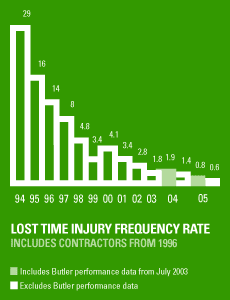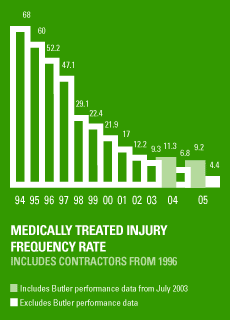YOU ARE HERE: CSE Report 2005 > Health & Safety > Safety Performance

BlueScope Steel employees and contractors continue to work more safely. Less people are being injured than ever before and more than ever, our Company is being cited as best practice in industrial safety. This does not however diminish our drive for further improvement.
We remain committed to our goal of Zero Harm.
In 2004/05, we achieved further reductions in our two key safety indicators: Lost Time Injury Frequency Rate (LTIFR) and Medically Treated Injury Frequency Rate (MTIFR).
Tragically, an otherwise improved safety performance was overshadowed by a fatality.
A Lost Time Injury (LTI) occurs when an employee is absent from work due to injury for at least one full shift. LTIFR is the number of lost time injuries per million hours worked (formerly known as man-hours).
Many companies use LTIFR to measure their safety performance and compare their performance with that of other companies and industries. Using a rate of injury, rather than the number of injuries, allows comparison between companies of different sizes.
In 2004/05, we improved our record low injury performance, achieving an LTIFR of less than one loss time injury per million hours worked. This compares exceptionally well to an international steel industry average of just under 10 - i.e. one tenth that of the international iron and steel industry.
MTIFR is the number of injuries that require medical treatment, per million hours worked. In the majority of BlueScope Steel's facilities, the MTIFR also continues to decrease to record-best levels. The graphs on this page show the impact of incorporating the Butler performance data from July 2003. The Butler business has now embraced our safety journey.
BlueScope Steel's substantial safety performance improvement, shown by a reduction in LTIFR from around 30 a decade ago to 2004/05 level of less than one, has been partly the result of our self-auditing process, which involves employees in hazard identification and risk management processes.
In 2004/05, 78 per cent of our people were involved in conducting monthly safety audits and the majority of teams have every person involved in audits on a monthly basis. Our newly acquired North American businesses have also made good progress. Prior to acquisition, audit participation rates were very low in these businesses, but in one year, they have achieved safety auditing involvement levels of over 60 per cent.
Another proactive strategy sees our people involved in more 'near miss' reporting than ever before. In the past year, more than 23,390 near misses were reported; all with valuable lessons learnt and appropriate actions progressed.


